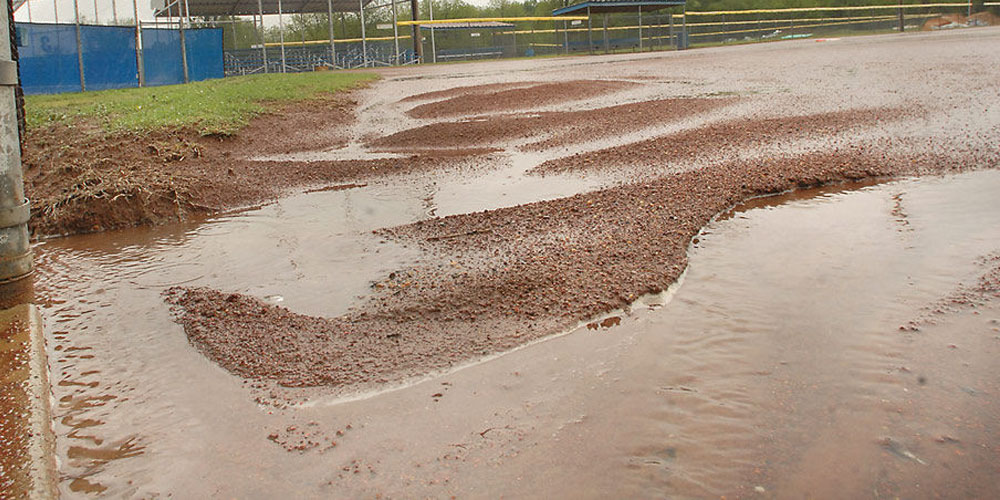How to Recover When Your Field Floods…
Every year there are many major challenges that confront the sports field manager: Late winter snow storms, frost depths, Bombogenesis Nor’easters, severe storms and tornadoes, heavy rains, and flooding. All work against field managers in meeting their deadlines to have their fields up and running on time, regardless of the season or sport. None of these weather events is more damaging and debilitating than a major flood on a sports field. It doesn’t matter if you have natural or artificial turf on your field, a flood is likely going to mean a whole lot of hard work ahead.
 There are two primary types of flooding.The first involves a constantly moving body of water across your field. While this can reduce the amount of sediment that will settle out on your playing surface, it could also wash out your skinned infield if you have a baseball or softball field, depending on the speed and movement of the water. Moving water can also do tremendous damage to artificial turf by floating the turf upward and then pushing it into ripples or piles on the field surface.
There are two primary types of flooding.The first involves a constantly moving body of water across your field. While this can reduce the amount of sediment that will settle out on your playing surface, it could also wash out your skinned infield if you have a baseball or softball field, depending on the speed and movement of the water. Moving water can also do tremendous damage to artificial turf by floating the turf upward and then pushing it into ripples or piles on the field surface.
The second type of flooding involves the rise and eventual fall of a fairly stagnant pond of flood water. This type of flooding will likely deposit a layer of silt and clay wherever the flood water exists since there is no current to keep the silt and clay suspended. This layer can suffocate turfgrass and seal up even the best drainage systems depending on how thick the layer is and how quickly it can be removed after the flood event.
9 KEY STEPS to recovering your fields after a flood:

-
- THE GOLDEN RULE: STAY OFF THE FIELD until all water is off and the ground is firm enough to support motorized equipment.
- Remove all large debris left behind by the flood.
- If sediment was deposited on the field, remove as much as possible on both grass areas and skinned infield areas. Scoop up and then wash off any remaining sediment on the turf blades immediately before the sediment dries too much.
- With the majority of the sediment removed,cultivate the field to further remove and dilute any remaining sediment. Aerify with hollow tines. Collect the cores and apply topdressing using clean soil that is identical or slightly more coarse than existing soil. Drag the topdressing in and finish with a nice roll to ensure a smooth playing field.
- If the turfgrass was badly damaged from the flood, then overseeding or sprigging in concert with the aerification process is the perfect answer to thickening your turf back to it’s previous glory.
- A flood will leach vital nutrients out of the soil. Remember to temporarily amp up your fertility program to build your nutrients back to proper levels for your turf and to assist the turf stand in it’s recovery.

- Flood waters can transport billions of weed seeds.Regularly scout your turf areas as recovery progresses. Chemically treat only if needed. As your turf stand recovers, the increased turf density should out compete most weeds.
- If flooding occurs during warm and humid weather, be alert for elevated disease activity due to ideal conditions and if possible treat preventatively as the existing turfgrass that survived will still be working to regain it’s strength and vigor.
- If you maintain an artificial turf field, flooding likely did some serious damage. Be sure to consult with your insurance company. Much of the remediation and repair may well be covered. But even then, it will still take an extended period of time to put the field back into play and make it safe for usage. Be sure to conduct a drainage analysis to gauge the status of the usually extensive drainage system. A certified installer for the type of turf system you have should be involved in evaluating what steps are needed to bring the artificial surface safely back on line.
Most importantly, after you have gone through an event like this at your facility, conduct a review of the event to identify what could have been done differently in the future to minimize damage to the facility and to ensure the safety of all who work and play there should a similar event happen again. Write up a plan, distribute it to all involved, and be sure that each person knows their responsibility to protect life and property.
The National Sports Turf Managers Association (STMA) and it’s charitable wing, the SAFE Foundation, have issued an excellent 5-page bulletin dealing with flooding on sports fields. Some of which was used for this blog. Click the button below to go to this well thought out information piece for sports fields managers and good luck during the sometimes violent weather ahead.
View Flood Recovery Products STMA Bulletin on Flooding



My friend is putting a sports field together, but he’s not sure how to keep it protected. It makes sense that avoiding flooding would be important! I can see how flooding would make it a lot harder to take care of the field.